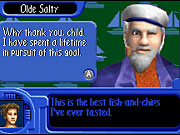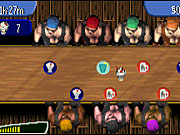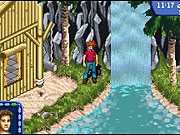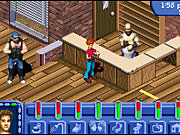The Sims Bustin' Out Preview
Maxis and EA pack a whole lot of living into the first Game Boy Advance version of The Sims franchise.
The Sims franchise has been an unparalleled juggernaut of popularity on the PC since it debuted in 2000. A number of well-received expansion packs have helped cement the series' reputation as a gaming phenomenon. The franchise expanded last year with a new evolution--created specifically for the current crop of consoles--that was well received, both critically and commercially. Given its warm reception, it's hardly surprising to hear that developer Maxis is prepping a follow-up to the console games. However, news of a Game Boy Advance version certainly was surprising. While translating the unique and deep gameplay of The Sims to home consoles went well last year, performing such a feat for a portable system with four buttons seems like insanity. However, after spending some time with The Sims Bustin' Out, which shares the same moniker as its upcoming console cousins, we have to say we're pleasantly surprised and very pleased with what Maxis and developer Griptonite Games have accomplished. The pair have taken the core gameplay experience from The Sims and married it with some basic structural RPG elements. The end result is a new Sims experience that's both fresh and portable.
For those who are unfamiliar with The Sims experience, the franchise revolves around the care of a virtual person, called a "sim." In the PC and last year's console games, you played the role of an omnipotent caretaker who tended to a sim's needs. The GBA game makes a radical change to the formula and puts you in the role of your sim. The same basic mechanics apply, so you'll still have to make sure your sim's core group of needs are sorted and met while trying to evolve your little charge from his or her lowly beginnings to a fabulous, fruitful life. How you do that has now been shaped into a much more traditional mission-oriented structure that is more in line with an RPG.
You'll start the game by creating your sim. You'll pick a name, gender, skin tone, hair style, hair color, shirt, pants, and shoes for him or her. Once that's sorted you'll distribute points between a set of 10 attributes that will determine your sim's personality. You'll also pick an astrological sign. Fans of the franchise may recognize the setup process, although the astrological sign no longer has an impact on your sim's personality. Instead, it ties into the exclusive items you'll encounter in the game, as each sign will have items exclusive to it. After you've run through all that, you'll start the game proper by reading a welcome-to-Sim Valley letter (Sim Valley is the game's setting) and watching a short cinema of your disembarkation at your Uncle Hayseed's farm. This starts you on your path to material and financial success.

The most refreshing thing about The Sims Bustin' Out for the Game Boy Advance is the way the gameplay has been shaped. You'll get your objectives, RPG-style, by interacting with characters in the game. As you do, they'll ask you to do things for them. Your tasks will start out simply enough, as initially you'll collect chickens, buy items, and decorate a room. Eventually your tasks will become more complex. Social interaction is an important part of the game, thanks to the plethora of characters with which to interact, each with his or her own disposition. While previous Sims games have pulled the game camera back quite a ways, The Sims Bustin' Out actually switches to a large head shot where you'll be treated to exaggerated facial animations to fill you in as to how your conversation is going. A meter on the right side of the screen lets you know how strong your relationship with that individual is by showing the points you earn in your chat. If you make the right selections, things will go down well, and you'll rake up the points. Building relationships is important in the game as some tasks require you to bond with certain individuals. As for tending to your sim's day-to-day needs, onscreen meters along the bottom of the screen track how sated your sim is in a particular area. Once a meter starts dipping, you'll have to interact with items in your pad or the environment to build them back up. If your sim is hungry, you'll have to eat some food; if they're dirty, you'll have to find a shower, and so on.
Another nice element of the game is the world in which you'll live. While your uncle's farm will be everything you know of the world for your first set of missions, as you start interacting with people and getting deeper into the game, you'll find a large world to explore that offers lots to do. While this would be less exciting if you were limited to exploring your environments on foot, the game provides you with a moped-like scooter that lets you get around in style.
Now, while all this sounds well and good, there's a downside to living your virtual life--much in like most people's real ones. We're, of course, talking about money. In The Sims Bustin' Out, the free ride at your uncle's will end, and you'll be forced to get a place of your own--at your own expense. As you'd expect, living the single life isn't cheap, as you'll have to keep yourself alive, pay rent, and furnish your digs. To earn currency, or simoleans as they're called, you'll have to work. You'll find eight career paths in the game, all of which are tied to the minigames you'll discover as you play. Most can be played just once a day (in game time) and will reward you with some cash. You'll need the money to deal with the various expenses you'll incur, from moving and eating to getting a bigger home. The minigames include a cool assortment of jobs that will have you mowing lawns, lifting weights, playing instruments, diving from cliffs, serving drinks, fishing, delivering pizza, and working in a lab. Each is similar, in feel, to old-school arcade classics, and each offers a nice way to earn some cash.
The minigames also come into play with The Sims Bustin' Out's connectivity to its GameCube cousin. If you connect the GBA game with the GameCube you'll be able to access an arcade cabinet that will let you play the minigames and transfer simoleons between the two. You'll also be able to transfer your GameCube sim over to take a tour of the GBA game. Another connectivity extra is an island that will open up when you connect two GBAs together. Much like the island unlocked in Animal Crossing, when you use the GBA, The Sims Bustin' Out will reward you with a summer home that you'll be able to store more stuff in.

As far as control goes, The Sims Bustin' Out keeps things simple and relies mainly on the A button to let you interact with people and objects. Approaching a person or thing and pressing A calls up a menu, and you can then choose how to interact with it. The D pad moves your sim around, and the B button lets you run. When you're on a scooter, A accelerates, and B lets you get off the scooter. As far as managing your sim's needs goes, you'll be able to see meters onscreen during gameplay. Additionally, you can check things out on the pause menu, which lets you cycle through a few different menus that track different information, like your current goals, what you're holding in your pockets, your popularity among the people you know, and the items you've collected either by discovery or purchase. You'll find an insanely large list of things to get in the game, and some, as mentioned before, are exclusive to your astrological sign.
The graphics are extremely impressive. Maxis and Griptonite didn't even bother with a polygonal approach for the game and have, instead, relied on a sprite-based engine that satisfies with large characters, smooth animation, and detailed environments. The in-close character portrait graphics are quite nice and do a fine job of complementing the character animation. Both elements do an excellent job of retaining the trademark sims humor. You'll notice some subtle concessions made for the game's "E" rating. For instance, the pixelation effect used to hide your sim's unmentionables, when in the bathroom and shower in the PC and console games, has been replaced by a far friendlier newspaper and steam cloud, respectively.
As impressive as the graphics are, the audio may well surpass them in terms of quality. The Sims Bustin' Out makes a fine case for the virtues of the Game Boy Advance's sound capabilities with an ambitious collection of sound effects, samples, and music. You'll hear quite a bit of simlish, the trademark language of the sims, as well as impressive ambient noises, like birds and crickets. One of the highlights, however, is the game's soundtrack, which includes a surprisingly funky collection of tunes.

From the time we've spent living in The Sims Bustin' Out, we have to say we're pleased by what Maxis and Griptonite are putting together. The limitations of the GBA appear to have afforded the team a new kind of freedom in developing a Sims game that looks as though it may be yet another cool evolution for the franchise. Anyone looking for a fun and addictive diversion will want to check out The Sims Bustin' Out when it ships this December. For a look at the first footage from the game check out media page here.
Got a news tip or want to contact us directly? Email news@gamespot.com

Join the conversation